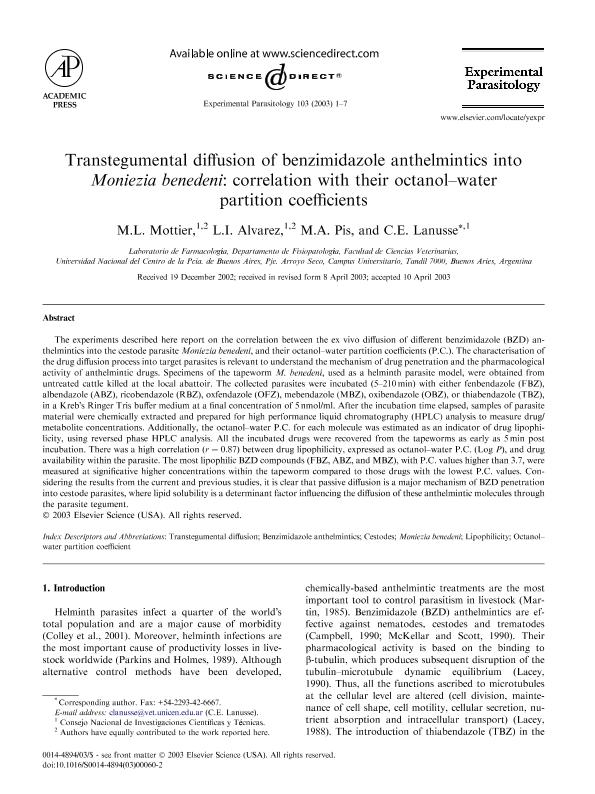Mostrar el registro sencillo del ítem
dc.contributor.author
Mottier, Maria de Lourdes

dc.contributor.author
Alvarez, Luis Ignacio

dc.contributor.author
Pis, Ma. Alejandra
dc.contributor.author
Lanusse, Carlos Edmundo

dc.date.available
2020-06-05T21:21:16Z
dc.date.issued
2003-01
dc.identifier.citation
Mottier, Maria de Lourdes; Alvarez, Luis Ignacio; Pis, Ma. Alejandra; Lanusse, Carlos Edmundo; Transtegumental diffusion of benzimidazole anthelmintics into Moniezia benedeni: correlation with their octanol–water partition coefficients; Academic Press Inc Elsevier Science; Experimental Parasitology; 103; 1-2; 1-2003; 1-7
dc.identifier.issn
0014-4894
dc.identifier.uri
http://hdl.handle.net/11336/106799
dc.description.abstract
The experiments described here report on the correlation between the ex vivo diffusion of different benzimidazole (BZD) anthelmintics into the cestode parasite Moniezia benedeni, and their octanol–water partition coefficients (P.C.). The characterisation of the drug diffusion process into target parasites is relevant to understand the mechanism of drug penetration and the pharmacological activity of anthelmintic drugs. Specimens of the tapeworm M. benedeni, used as a helminth parasite model, were obtained from untreated cattle killed at the local abattoir. The collected parasites were incubated (5–210 min) with either fenbendazole (FBZ),albendazole (ABZ), ricobendazole (RBZ), oxfendazole (OFZ), mebendazole (MBZ), oxibendazole (OBZ), or thiabendazole (TBZ), in a Kreb’s Ringer Tris buffer medium at a final concentration of 5 nmol/ml. After the incubation time elapsed, samples of parasite material were chemically extracted and prepared for high performance liquid chromatography (HPLC) analysis to measure drug/metabolite concentrations. Additionally, the octanol–water P.C. for each molecule was estimated as an indicator of drug lipophilicity,using reversed phase HPLC analysis. All the incubated drugs were recovered from the tapeworms as early as 5 min post incubation. There was a high correlation (r ¼ 0:87) between drug lipophilicity, expressed as octanol–water P.C. (Log P), and drug availability within the parasite. The most lipophilic BZD compounds (FBZ, ABZ, and MBZ), with P.C. values higher than 3.7, were measured at significative higher concentrations within the tapeworm compared to those drugs with the lowest P.C. values. Considering the results from the current and previous studies, it is clear that passive diffusion is a major mechanism of BZD penetration into cestode parasites, where lipid solubility is a determinant factor influencing the diffusion of these anthelmintic molecules through the parasite tegument.
dc.format
application/pdf
dc.language.iso
eng
dc.publisher
Academic Press Inc Elsevier Science

dc.rights
info:eu-repo/semantics/openAccess
dc.rights.uri
https://creativecommons.org/licenses/by-nc-sa/2.5/ar/
dc.subject
BENZIMIDAZOLE
dc.subject
ANTHELMINTICS
dc.subject
MONIEZIA BENEDENI
dc.subject.classification
Ciencias Veterinarias

dc.subject.classification
Ciencias Veterinarias

dc.subject.classification
CIENCIAS AGRÍCOLAS

dc.title
Transtegumental diffusion of benzimidazole anthelmintics into Moniezia benedeni: correlation with their octanol–water partition coefficients
dc.type
info:eu-repo/semantics/article
dc.type
info:ar-repo/semantics/artículo
dc.type
info:eu-repo/semantics/publishedVersion
dc.date.updated
2020-06-05T16:16:16Z
dc.identifier.eissn
1090-2449
dc.journal.volume
103
dc.journal.number
1-2
dc.journal.pagination
1-7
dc.journal.pais
Estados Unidos

dc.journal.ciudad
Cambridge
dc.description.fil
Fil: Mottier, Maria de Lourdes. Universidad Nacional del Centro de la Provincia de Buenos Aires. Facultad de Ciencias Veterinarias. Departamento de Fisiopatología. Laboratorio de Farmacología; Argentina. Consejo Nacional de Investigaciones Científicas y Técnicas; Argentina
dc.description.fil
Fil: Alvarez, Luis Ignacio. Consejo Nacional de Investigaciones Científicas y Técnicas; Argentina. Universidad Nacional del Centro de la Provincia de Buenos Aires. Facultad de Ciencias Veterinarias. Departamento de Fisiopatología. Laboratorio de Farmacología; Argentina
dc.description.fil
Fil: Pis, Ma. Alejandra. Universidad Nacional del Centro de la Provincia de Buenos Aires. Facultad de Ciencias Veterinarias. Departamento de Fisiopatología. Laboratorio de Farmacología; Argentina
dc.description.fil
Fil: Lanusse, Carlos Edmundo. Universidad Nacional del Centro de la Provincia de Buenos Aires. Facultad de Ciencias Veterinarias. Departamento de Fisiopatología. Laboratorio de Farmacología; Argentina. Consejo Nacional de Investigaciones Científicas y Técnicas; Argentina
dc.journal.title
Experimental Parasitology

dc.relation.alternativeid
info:eu-repo/semantics/altIdentifier/doi/http://dx.doi.org/10.1016/S0014-4894(03)00060-2
dc.relation.alternativeid
info:eu-repo/semantics/altIdentifier/url/https://www.sciencedirect.com/science/article/abs/pii/S0014489403000602
Archivos asociados
